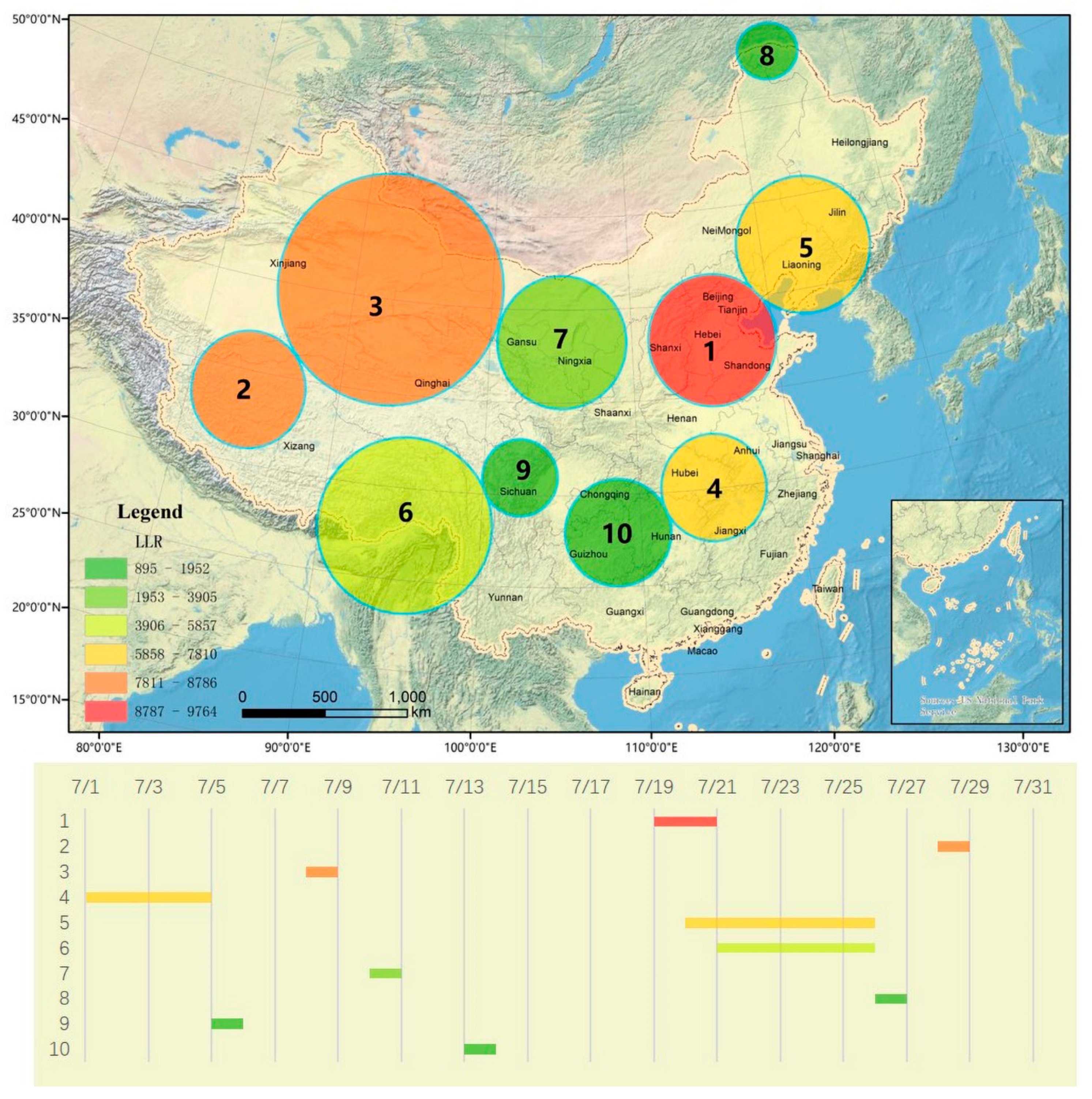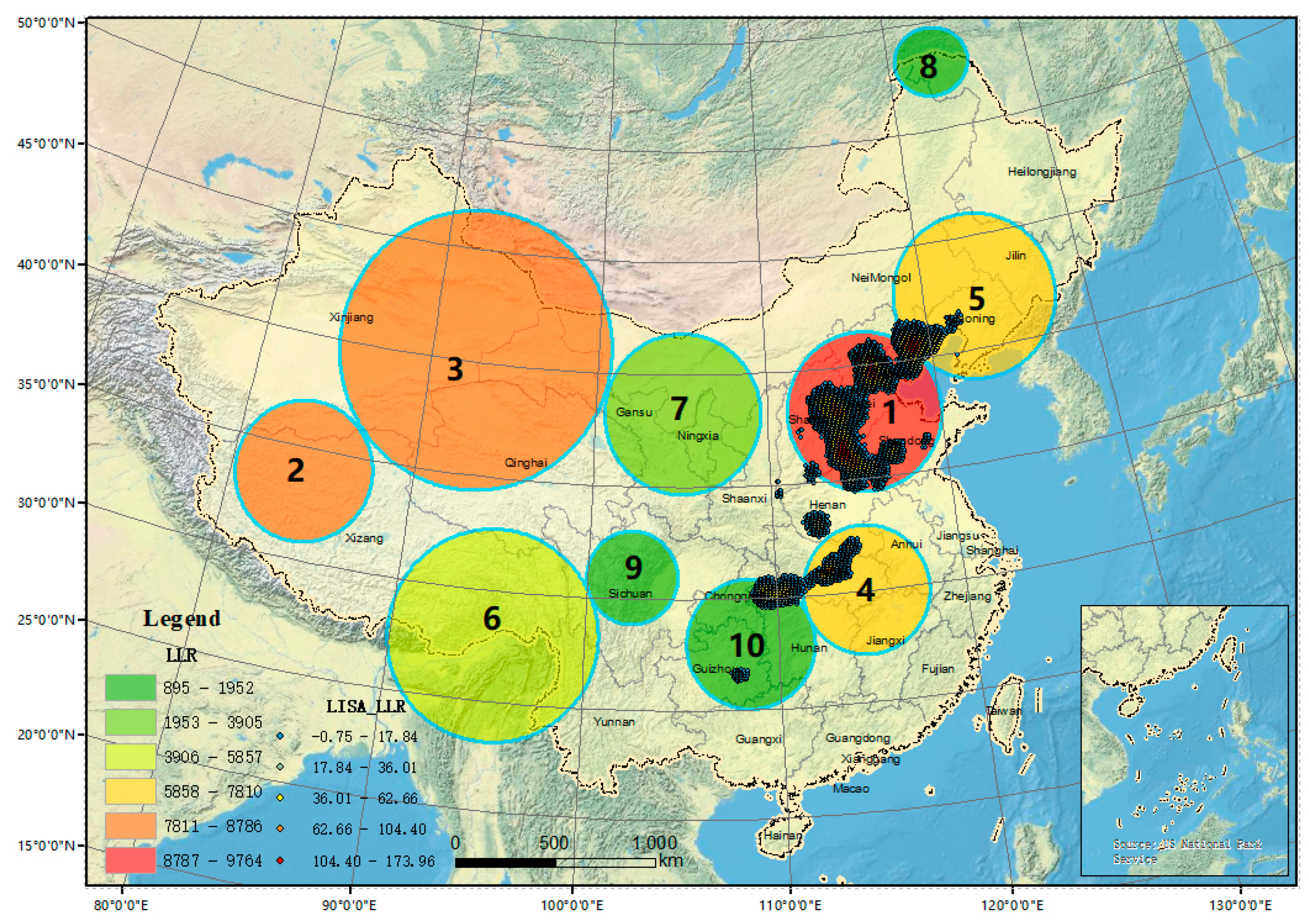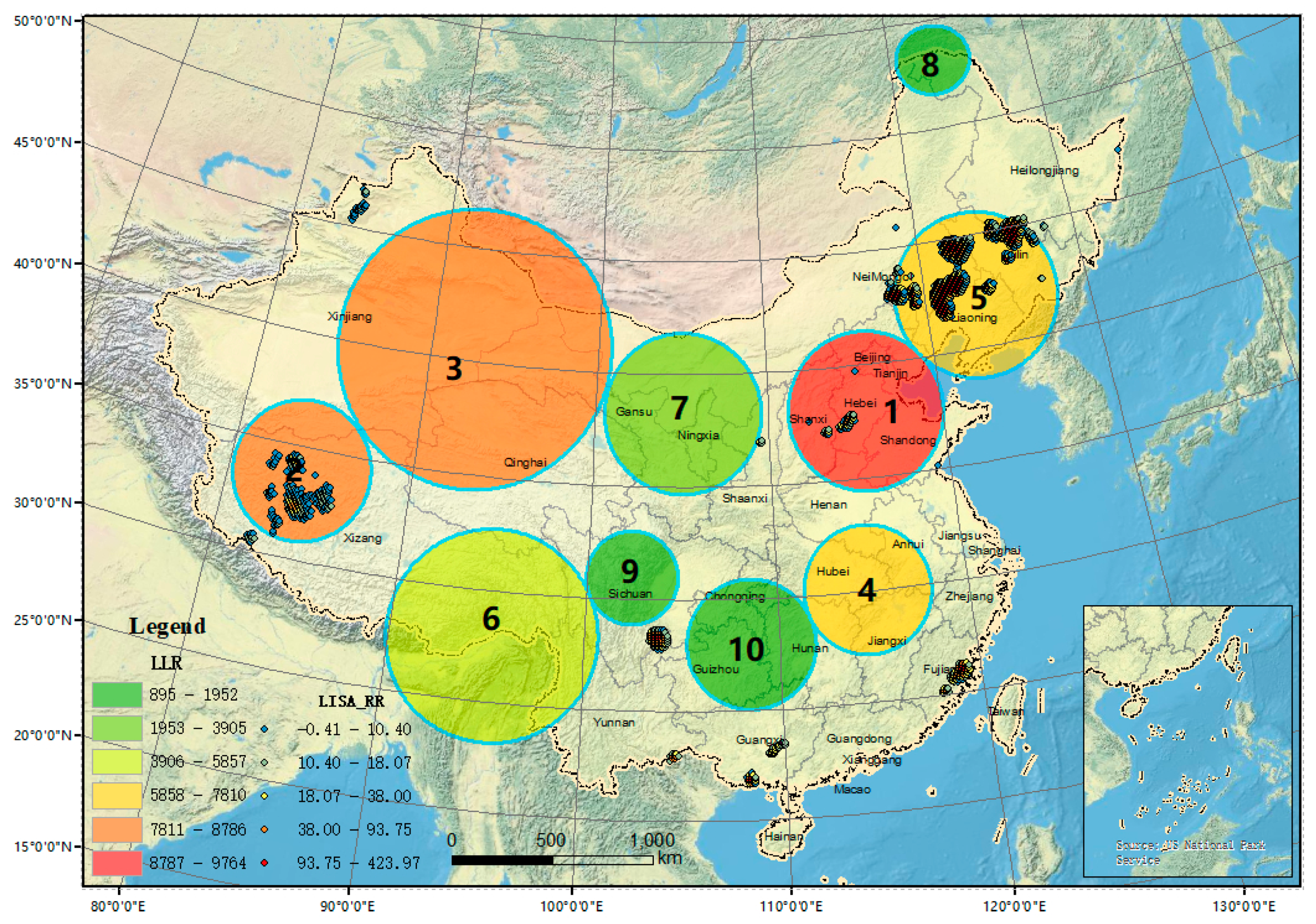Recognizing the Aggregation Characteristics of Extreme Precipitation Events Using Spatio-Temporal Scanning and the Local Spatial Autocorrelation Model
Abstract
:1. Introduction
2. Materials and Methods
2.1. Data
2.2. Extreme Precipitation Threshold Extraction Method
2.3. Spatio-Temporal Scanning Model
2.4. Local Spatial Autocorrelation Model
2.5. Experimental Process
3. Results
3.1. Spatio-Temporal Aggregation Characteristics of Extreme Precipitation Events
3.2. Internal Spatio-Temporal Aggregation Characteristics with the Local Spatial Autocorrelation Model
4. Discussion
5. Conclusions
Author Contributions
Funding
Acknowledgments
Conflicts of Interest
References
- Tammets, T.; Jaagus, J. Climatology of precipitation extremes in Estonia using the method of moving precipitation totals. Theor. Appl. Climatol. 2013, 111, 623–639. [Google Scholar] [CrossRef]
- Zhang, Q.; Zhou, Y.; Singh, V.P.; Li, J. Scaling and clustering effects of extreme precipitation distributions. J. Hydrol. 2012, 454, 187–194. [Google Scholar] [CrossRef]
- Shukla, R.; Agarwal, A.; Sachdeva, K.; Kurths, J.; Joshi, P.K. Climate change perception: An analysis of climate change and risk perceptions among farmer types of Indian Western Himalayas. Clim. Chang. 2019, 152, 103–119. [Google Scholar] [CrossRef]
- Alexander, L.V.; Zhang, X.; Peterson, T.C.; Caesar, J.; Gleason, B.; Klein Tank, A.M.G.; Tagipour, A. Global observed changes in daily climate extremes of temperature and precipitation. J. Geophys. Res. Atmos. 2006, 111, 5. [Google Scholar] [CrossRef] [Green Version]
- Allan, R.P.; Soden, B.J. Atmospheric warming and the amplification of precipitation extremes. Science 2008, 321, 1481–1484. [Google Scholar] [CrossRef] [PubMed] [Green Version]
- Gao, T.; Xie, L. Study on progress of the trends and physical causes of extreme precipitation in China during the last 50 years. Adv. Earth Sci. 2014, 29, 577–589. [Google Scholar]
- IPCC Climate Change. The Physical Science Basis. Working Group I Contribution to the Fifth Assessment Report of the Intergovernmental Panel on Climate Change; Cambridge University Press: Cambridge, UK, 2013. [Google Scholar]
- Dai, A.; Trenberth, K.E.; Karl, T.R. Global variations in droughts and wet spells: 1900–1995. Geophys. Res. Lett. 1998, 25, 3367–3370. [Google Scholar] [CrossRef] [Green Version]
- Goswami, B.N.; Venugopal, V.; Sengupta, D.; Madhusoodanan, M.S.; Xavier, P.K. Increasing trend of extreme rain events over India in a warming environment. Science 2006, 314, 1442–1445. [Google Scholar] [CrossRef] [Green Version]
- Liu, B.; Chen, J.; Chen, X.; Lian, Y.; Wu, L. Uncertainty in determining extreme precipitation thresholds. J. Hydrol. 2013, 503, 233–245. [Google Scholar] [CrossRef]
- Min, S.; Qian, Y.F. Regionality and persistence of extreme precipitation events in China. Adv. Water Sci. 2008, 19, 763–771. [Google Scholar]
- Yang, P. Research of Group-occurring Extreme Temperature and Precipitation Events during 1960–2005. Ph.D. Thesis, Lanzhou University, Lanzhou, China, 2009. [Google Scholar]
- Cheung, K.K.; Ozturk, U. Synchronization of extreme rainfall during the Australian summer monsoon: Complex network perspectives. Chaos Interdiscip. J. Nonlinear Sci. 2020, 30, 063117. [Google Scholar] [CrossRef] [PubMed]
- Kunkel, K.E.; Easterling, D.R.; Redmond, K.; Hubbard, K. Temporal variations of extreme precipitation events in the United States: 1895–2000. Geophys. Res. Lett. 2003, 30, 17. [Google Scholar] [CrossRef] [Green Version]
- Groisman, P.Y.; Knight, R.W.; Easterling, D.R.; Karl, T.R.; Hegerl, G.C.; Razuvaev, V.N. Trends in intense precipitation in the climate record. J. Clim. 2005, 18, 1326–1350. [Google Scholar] [CrossRef]
- Ren, F.; Cui, D.; Gong, Z.; Wang, Y.; Zou, X.; Li, Y.; Wang, X. An objective identification technique for regional extreme events. J. Clim. 2012, 25, 7015–7027. [Google Scholar] [CrossRef]
- Easterling, D.R.; Evans, J.L.; Groisman, P.Y.; Karl, T.R.; Kunkel, K.E.; Ambenje, P. Observed variability and trends in extreme climate events: A brief review. Bull. Am. Meteorol. Soc. 2000, 81, 417–426. [Google Scholar] [CrossRef] [Green Version]
- Biondi, F.; Kozubowski, T.J.; Panorska, A.K. Stochastic modeling of regime shifts. Clim. Res. 2002, 23, 23–30. [Google Scholar] [CrossRef]
- Biondi, F.; Kozubowski, T.J.; Panorska, A.K.; Saito, L. A new stochastic model of episode peak and duration for eco-hydro-climatic applications. Ecol. Model. 2008, 211, 383–395. [Google Scholar] [CrossRef]
- Blanchet, J.; Ceresetti, D.; Molinié, G.; Creutin, J.D. A regional GEV scale-invariant framework for Intensity–Duration–Frequency analysis. J. Hydrol. 2016, 540, 82–95. [Google Scholar] [CrossRef]
- Gentilucci, M.; Barbieri, M.; Lee, H.S.; Zardi, D. Analysis of rainfall trends and extreme precipitation in the Middle Adriatic Side, Marche Region (Central Italy). Water 2019, 11, 1948. [Google Scholar] [CrossRef] [Green Version]
- Jing, C.; Jiang, T.; Wang, Y.J.; Chen, J.; Jian, D.; Luo, L.; Buda, S.U. A study on regional extreme precipitation events and the exposure of population and economy in China. Acta Meteor. Sin. 2016, 74, 572–582. [Google Scholar]
- Andreadis, K.M.; Clark, E.A.; Wood, A.W.; Hamlet, A.F.; Lettenmaier, D.P. Twentieth-century drought in the conterminous United States. J. Hydrometeorol. 2005, 6, 985–1001. [Google Scholar] [CrossRef]
- Yuan, N.; Fu, Z.; Mao, J. Different scaling behaviors in daily temperature records over China. Phys. A Stat. Mech. Appl. 2010, 389, 4087–4095. [Google Scholar] [CrossRef]
- Chen, Y.; Zhai, P. Persistent extreme precipitation events in China during 1951–2010. Clim. Res. 2013, 57, 143–155. [Google Scholar] [CrossRef] [Green Version]
- Ghosh, S.; Mallick, B.K. A hierarchical Bayesian spatio-temporal model for extreme precipitation events. Environmetrics 2011, 22, 192–204. [Google Scholar] [CrossRef]
- Zhang, Q.; Singh, V.P.; Li, J.; Jiang, F.; Bai, Y. Spatio-temporal variations of precipitation extremes in Xinjiang, China. J. Hydrol. 2012, 434, 7–18. [Google Scholar] [CrossRef]
- Agarwal, A. Unraveling Spatio-Temporal Climatic Patterns via Multi-Scale Complex Networks. Ph.D. Thesis, Universität Potsdam, Potsdam, Germany, 2019. [Google Scholar]
- Naus, J.I. The distribution of the size of the maximum cluster of points on a line. J. Am. Stat. Assoc. 1965, 60, 532–538. [Google Scholar] [CrossRef]
- Kulldorff, M.; Nagarwalla, N. Spatial disease clusters: Detection and inference. Stat. Med. 1995, 14, 799–810. [Google Scholar] [CrossRef]
- Kulldorff, M.; Athas, W.F.; Feurer, E.J.; Miller, B.A.; Key, C.R. Evaluating cluster alarms: A space-time scan statistic and brain cancer in Los Alamos, New Mexico. Am. J. Public Health 1998, 88, 1377–1380. [Google Scholar] [CrossRef] [Green Version]
- Kim, Y.; O’Kelly, M. A bootstrap based space–time surveillance model with an application to crime occurrences. J. Geogr. Syst. 2008, 10, 141–165. [Google Scholar] [CrossRef]
- Horn, L.M. Precipitation Associated with Increased Diarrheal Disease in Mozambique; A Time Series Analysis. Ph.D. Thesis, University of Washington, Washington, DC, USA, 2017. [Google Scholar]
- Ye, S.J.; Lu, S.H.; Bai, X.S.; Gu, J.F. ResNet-Locust-BN network-based automatic identification of east asian migratory locust species and instars from RGB images. Insects 2020, 11, 458. [Google Scholar] [CrossRef] [PubMed]
- Gong, D.Y.; Wang, S.W. Severe summer rainfall in China associated with enhanced global warming. Clim. Res. 2000, 16, 51–59. [Google Scholar] [CrossRef]
- Yao, C.; Yang, S.; Qian, W.; Lin, Z.; Wen, M. Regional summer precipitation events in Asia and their changes in the past decades. J. Geophys. Res. Atmos. 2008, 113, 17. [Google Scholar] [CrossRef] [Green Version]
- Sun, Q.H.; Miao, C.Y.; Duan, Q.Y. Changes in the Spatial Heterogeneity and Annual Distribution of Observed Precipitation across China. J. Clim. 2017, 30, 9399–9416. [Google Scholar] [CrossRef]
- Miao, C.Y.; Duan, Q.Y.; Sun, Q.H.; Lei, X.H.; Li, H. Non-uniform changes in different categories of precipitation intensity across China and the associated large-scale circulations. Environ. Res. Lett. 2019, 14. [Google Scholar] [CrossRef]
- Xie, P.; Janowiak, J.E.; Arkin, P.A.; Adler, R.; Gruber, A.; Ferraro, R.; Curtis, S. GPCP pentad precipitation analyses: An experimental dataset based on gauge observations and satellite estimates. J. Clim. 2003, 16, 2197–2214. [Google Scholar] [CrossRef] [Green Version]
- Higgins, R.W.; Silva, V.B.S.; Shi, W.; Larson, J. Relationships between climate variability and fluctuations in daily precipitation over the United States. J. Clim. 2007, 20, 3561–3579. [Google Scholar] [CrossRef]
- Ye, S.J.; Zhu, D.H.; Yao, X.C.; Zhang, N.; Fang, S.; Li, L. Development of a Highly Flexible Mobile GIS-Based System for Collecting Arable Land Quality Data. IEEE J. Sel. Top. Appl. Earth Obs. Remote Sens. 2014, 5, 14. [Google Scholar] [CrossRef]
- Yatagai, A.; Arakawa, O.; Kamiguchi, K.; Kawamoto, H.; Nodzu, M.I.; Hamada, A. A 44-year daily gridded precipitation dataset for Asia based on a dense network of rain gauges. Sola 2009, 5, 137–140. [Google Scholar] [CrossRef] [Green Version]
- Yang, K. China Meteorological Forcing Data (1979–2018). Nat. Tibet. Plateau Data Cent. 2018. [Google Scholar] [CrossRef]
- Yang, K.; He, J.; Tang, W.; Qin, J.; Cheng, C.C. On downward shortwave and longwave radiations over high altitude regions: Observation and modeling in the Tibetan Plateau. Agric. Forest Meteorol. 2010, 150, 38–46. [Google Scholar] [CrossRef]
- He, J.; Yang, K.; Tang, W.; Lu, H.; Qin, J.; Chen, Y.; Li, X. The first high-resolution meteorological forcing dataset for land process studies over China. Sci. Data 2020, 7, 1–11. [Google Scholar] [CrossRef] [Green Version]
- Ye, S.J.; Yan, T.L.; Yue, Y.-L.; Lin, W.-Y.; Li, L.; Yao, X.-C.; Mu, Q.-Y.; Li, Y.-Q.; Zhu, D. Developing a reversible rapid coordinate transformation model for the cylindrical projection. Comput. Geosci. 2016, 89, 44–56. [Google Scholar] [CrossRef]
- Ye, S.; Liu, D.; Yao, X.; Tang, H.; Xiong, Q.; Zhuo, W.; Du, Z.; Huang, J.; Su, W.; Shen, S.; et al. RDCRMG: A Raster Dataset Clean & Reconstitution Multi-Grid Architecture for Remote Sensing Monitoring of Vegetation Dryness. Remote Sens. 2018, 10, 1376. [Google Scholar] [CrossRef] [Green Version]
- Sokal, R.R.; Thomson, J.D. Applications of spatial autocorrelation in ecology. In Develoments in Numerical Ecology; Springer: Berlin/Heidelberg, Germany, 1987; pp. 431–466. [Google Scholar]
- Ord, J.K.; Getis, A. Testing for local spatial autocorrelation in the presence of global autocorrelation. J. Reg. Sci. 2001, 41, 411–432. [Google Scholar] [CrossRef]
- Wang, P.A.; Luo, W.H.; Bai, Y.P. Comparative analysis of aggregation detection based on spatial autocorrelation and spatial-temporal scan statistics. Hum. Geogr. 2012, 27, 119–127. [Google Scholar]
- Ye, S.J.; Song, C.Q.; Shen, S.; Gao, P.C.; Cheng, C.X.; Cheng, F.; Wan, C.J.; Zhu, D.H. Spatial pattern of arable land-use intensity in China. Land Use Policy 2020, 99, 104845. [Google Scholar] [CrossRef]
- Ye, S.J.; Cheng, C.X.; Song, C.Q.; Shen, S. Visualizing bivariate local spatial autocorrelation between commodity revealed comparative advantage index of China and USA from a new space perspective. Environ. Plan. A Econ. Space 2020, 9. [Google Scholar] [CrossRef]
- Sherman, R.L.; Henry, K.A.; Tannenbaum, S.L.; Feaster, D.J.; Kobetz, E.; Lee, D.J. Peer reviewed: Applying spatial analysis tools in public health: An example using SaTScan to detect geographic targets for colorectal cancer screening interventions. Prev. Chronic Dis. 2014, 11, E41. [Google Scholar] [CrossRef] [PubMed] [Green Version]
- BI, B.; Zhang, X.; Dai, K. Characteristics of 2016 severe convective weather and extreme rainfalls under the background of super El Niño. Chin. Sci. Bull. 2017, 62, 928–937. [Google Scholar] [CrossRef] [Green Version]
- Gao, R.; Song, L.C.; Zhong, H.L. Characteristics of extreme precipitation in China during the 2016 flood season and comparison with the 1998 situation. Meteor Mon. 2018, 44, 699–703. [Google Scholar]
- Zhou, G.L.; Gao, W.Q.; Huang, C.X. Analysis of the extreme rainstorm events in China in 2016. China Flood Control Drought Relief 2017, 27, 75. (In Chinese) [Google Scholar]








| Cluster Date | Cluster Region | Number of Events | Expected Events | Log Likelihood Ratio | Relative Risk | p-Value |
|---|---|---|---|---|---|---|
| 2016/07/19–2016/07/20 | 1 | 6000 | 707.01 | 9763.16 | 8.69 | 0.001 |
| 2016/07/28–2016/07/28 | 2 | 3598 | 287.49 | 8634.29 | 12.70 | 0.001 |
| 2016/07/08–2016/07/08 | 3 | 6703 | 1079.89 | 8130.93 | 6.36 | 0.001 |
| 2016/07/01–2016/07/04 | 4 | 5819 | 931.85 | 7091.63 | 6.38 | 0.001 |
| 2016/07/20–2016/07/25 | 5 | 8874 | 2201.44 | 6724.74 | 4.15 | 0.001 |
| 2016/07/21–2016/07/25 | 6 | 6505 | 1903.84 | 3937.85 | 3.49 | 0.001 |
| 2016/07/10–2016/07/10 | 7 | 2474 | 390.88 | 3041.10 | 6.39 | 0.001 |
| 2016/07/26–2016/07/26 | 8 | 677 | 57.90 | 1493.53 | 11.73 | 0.001 |
| 2016/07/05–2016/07/05 | 9 | 879 | 122.00 | 1221.12 | 7.23 | 0.001 |
| 2016/07/13–2016/07/13 | 10 | 1047 | 232.35 | 895.07 | 4.52 | 0.001 |
Publisher’s Note: MDPI stays neutral with regard to jurisdictional claims in published maps and institutional affiliations. |
© 2021 by the authors. Licensee MDPI, Basel, Switzerland. This article is an open access article distributed under the terms and conditions of the Creative Commons Attribution (CC BY) license (http://creativecommons.org/licenses/by/4.0/).
Share and Cite
Wan, C.; Cheng, C.; Ye, S.; Shen, S.; Zhang, T. Recognizing the Aggregation Characteristics of Extreme Precipitation Events Using Spatio-Temporal Scanning and the Local Spatial Autocorrelation Model. Atmosphere 2021, 12, 218. https://doi.org/10.3390/atmos12020218
Wan C, Cheng C, Ye S, Shen S, Zhang T. Recognizing the Aggregation Characteristics of Extreme Precipitation Events Using Spatio-Temporal Scanning and the Local Spatial Autocorrelation Model. Atmosphere. 2021; 12(2):218. https://doi.org/10.3390/atmos12020218
Chicago/Turabian StyleWan, Changjun, Changxiu Cheng, Sijing Ye, Shi Shen, and Ting Zhang. 2021. "Recognizing the Aggregation Characteristics of Extreme Precipitation Events Using Spatio-Temporal Scanning and the Local Spatial Autocorrelation Model" Atmosphere 12, no. 2: 218. https://doi.org/10.3390/atmos12020218






